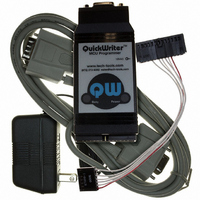QW1 TechTools, QW1 Datasheet - Page 5
Specifications of QW1
Contents
MCU Programmer with In-Circuit Serial Programming Cable and Optional GANG Adapters
For Use With/related Products
PIC Micro® MCU
For Use With
CBL-ICSP - CABLE PROG QUICKWRITER SERIALQW-4SSOP18 - ADAPTER QUICKWRITER 4GANG 18SSOPQW-4SSOP28 - ADAPTER QUICKWRITER 4GANG 28SSOPQW-4SO8/14W - ADAPT QUICKWRTR 4GANG 8/14SOIC WQW-4SO8/14N - ADAPT QUICKWRTR 4GANG 8/14SOIC NQW-4SOIC18 - ADAPTER QUICKWRITER 4GANG 18SOICQW-4ZIF18 - ADAPTER QUICKWRITER 4-GANG 18ZIFQW-4SOIC28 - ADAPTER QUICKWRITER 4GANG 28SOICQW-4PLCC44 - ADAPTER QUICKWRITER 4GANG 44PLCCQW-4ZIF40/28 - ADAPT QUICKWRITER 4GANG 40/28ZIFMP-ZIF14 - ADAPTER QUICKWRITER 14-PIN ZIFMP-SOIC8/14 - ADAPTER QUICKWRITER 8/14-SOICMP-SSOP18 - ADAPTER QUICKWRITER 18-SSOPMP-SSOP28 - ADAPTER QUICKWRITER 28-SSOPMP-14000 - ADAPTR QUICKWRTR PIC14000 28-PINMP-SOIC18 - ADAPTER QUICKWRITER 18-SOICMP-SOIC28 - ADAPTER QUICKWRITER 28-SOICMP-PLCC44 - ADAPTER QUICKWRITER 44-PIN PLCCMP-ZIF18/28 - ADAPTER QUICKWRITER 18/28PIN ZIFMP-ZIF40 - ADAPTER QUICKWRITER 40-PIN ZIF
Available stocks
Company
Part Number
Manufacturer
Quantity
Price
Company:
Part Number:
QW152
Manufacturer:
Laird Technologies IAS
Quantity:
135
Self Powered
This is often the best choice. It eliminates any concern over back-feeding power supplies or about
multi-voltage targets being partially powered. It most closely mimics the target’s intended
operational modes. However, there is one situation in which programmer powered is better.
Internal MCLR
We normally use MCLR to hold the chip in reset until we are ready to enter programming mode.
At that time, we quickly drive MCLR to VPP levels. To properly enter programming mode, we
must drive MCLR to VPP before the oscillator has run more than a few dozen cycles. Otherwise,
the device begins to run and advances the program counter before we get into programming
mode. The result is that we start programming beyond the start of code space, causing a failure.
Some devices have the option of configuring them for internal MCLR, freeing up a pin for general
I/O usage. However, once the pin is programmed as an I/O pin instead of a MCLR function, we
can no longer hold the chip in reset. It simply starts running as soon as it is powered. This
makes it much more difficult to ensure we get MCLR up to VPP levels before the PC starts
advancing, particularly during in-circuit programming.
Microchip solved this ‘catch-22’ by changing the programming specs for these devices so that we
apply VPP BEFORE VCC. This forces the chip into programming mode even if its MCLR function
has been internalized, but ONLY if we can control VCC as well as VPP.
For these devices, it is desirable to allow the programmer to control VCC so that it can properly
enter programming mode, even if the device has been previously programmed to use internal
MCLR. You can further increase the probability of success by enabling the device’s power up
timer. This causes the device to wait longer before starting to execute code.
If other limitations preclude powering the target from the programmer, you could still program
factory fresh devices. You just may not be able to re-program them or to do another verify AFTER
the fuses are programmed. During normal programming, we program and verify everything but
the fuses and THEN program the configuration fuses. The configuration fuses are the last things
we program so we maintain control over MCLR until the very last operation. Once the fuses are
programmed to internalize MCLR, we would loose control over the device.
Another possibility might be to use the programmer’s VCC to control a small relay that actually
powers the target. Make sure the relay coil uses less than 100ma at 5VDC and that you provide
a reverse biased diode across the coil to absorb any inductive ‘kick’ when the relay is opened.
GND (3)
Always connect the programmer’s ground to the target’s ground.


















